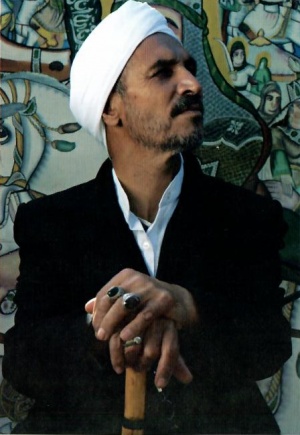Mohammad ali darvishi
Mohammad Ali Darvishi (born in 1956) is a prominent Pardekhan and Ma’rekegir. Darvish Mohammad Ali learned Pardekhani with abstract performance from his father who is one of the known curtain-storytellers. Apparent indications to the portraits of the curtain, the earth, the sky, the audience and himself and the creation of the sequence of repeated indications in order to attend God remembrance, makes up the general structure of the performance method of this singer narrator.
Mohammad ali darvishi | |
|---|---|
 | |
| Born | 1956 Neishabur |
| Nationality | Iranian |
| Known for | Pardekhani and Ma'rekegiri |
| Patron(s) | Gholam Reza Darvishi (his father) |
Performance Method
The deep look at the close points and towards the curtain and connecting this look along with a look at the far horizon and joining the sequence of apparent indications to esoteric indications complete his performance. A combination of hands and body motions, or taking thought-provoking postures make up a technique of passages from the self to the curtain, from curtain to the audience, from audience to the exoteric or esoteric meanings of the curtain. Therefore, the curtain - storytelling takes us with a hermeneutic method using repeated gestures indicating the past, a place where the time and place of the events take on the same direction as our knowledge because we are aware of everything. At the same time the events happen again, the violence of the suffering flows through us and inexpressible compassion attracts us. Such influence on the audience is only possible with mastery of complicated abstract techniques. The Pardekhan (curtain-storyteller) in the process is a symbol of untainted beliefs of the people and reference to which is made possible through Pardekhani.
Reciting Method
Darvish Mohammad Ali uses both free metre and a specific metre in performing. Most often he uses a prayer-like tone, and similar sounding sentence to carry on in performance. Repetitive rhythmic motifs constitute the characteristic of this performance. Finally some reference to known Iranian songs completes his narration. According to the technical survey the first part of the Pardekhani is performed with the intervals of Shur and the Pardekhan uses the notes of the first tetrachord up to the second note of the second tetrachord. There is no correspondence between Ali Darvishi's performance and the Shur Dastgah (mode) in terms of the melodic movement and even some of the notes (like the second note which the Pardekhani rises to a somewhat higher pitch). However, there is a correspondence in the total lack of using Pishdong of this Dastgah which belongs to the method of some of the Radifs, and even in the steplike, movement in his singing towards the higher pitches . The next section is performed with a prose narration after which the Pardekhan maintains the notes creating an atmosphere similar to Nava Dastgah (mode) . In this section the accents and the pauses are on the fourth note of Shur mode and the range of melodies goes beyond one tetrachord (up to the octave of Shur) and the pauses are transferred gradually to the first Shur tetrachord and resting on the second note of Shur and a melody similar to Avaz-e Abuata is heard. The performance continues with the prose-narration and Abu-ata song (avaz) can be heard once again in a higher pitch.
Narration
Darvish Mohammad Ali narrates the gathering of Saqqakhane (cistern) of Ismail Talai. The story takes place in the sacred city of Mashhad, location of the martyrdom of Imam Rida. The young Ismail goes to buy oil and bread at his mother's request. On the way he decides to pay a pilgrim's visit to the shrine of Imam Rida and then do the shopping. There he sees a darvish who narrates the tale of the martyrdom and being stranger in a foreign land of the saints in a Pardekhani performance. The goodhearted Ismail gives the money for the oil and the bread to the darvish. Asking for the aid of Imam Rida, he succeeds in overcome his mother's hesitations about him and the gifts that a stranger gave him (bread and gold coins). Ismail builds a cistern in Imam Rida's shrine with the gold coins.
Source
- Ardalan, hamidreza (2008). Picture-storyteller masters of iran, the Iranian academy of the art, 2008, volume 24. ISBN: 978-964-2986-507(vol.24). 978-964-2986-002(set).